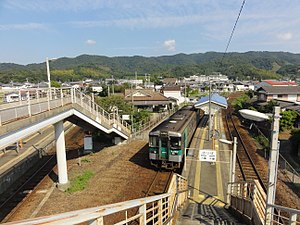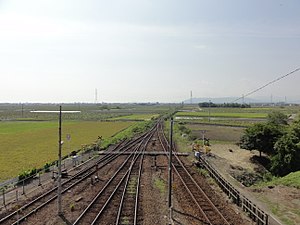Ikenotani Station
T04N04 Ikenotani Station Trì cốc dịch | ||||||||||||||||||||||||||
|---|---|---|---|---|---|---|---|---|---|---|---|---|---|---|---|---|---|---|---|---|---|---|---|---|---|---|
 Ikenotani Station in 2022 | ||||||||||||||||||||||||||
| General information | ||||||||||||||||||||||||||
| Location | Yanaginomoto-100 Ōasachō Ikenotani,Naruto- City,Tokushima Prefecture779-0303 Japan | |||||||||||||||||||||||||
| Coordinates | 34°9′11″N134°31′44″E/ 34.15306°N 134.52889°E | |||||||||||||||||||||||||
| Operated by | ||||||||||||||||||||||||||
| Line(s) | ||||||||||||||||||||||||||
| Distance |
| |||||||||||||||||||||||||
| Platforms | 2island platforms | |||||||||||||||||||||||||
| Tracks | 4 | |||||||||||||||||||||||||
| Construction | ||||||||||||||||||||||||||
| Structure type | At grade | |||||||||||||||||||||||||
| Accessible | No - island platforms accessed by footbridge | |||||||||||||||||||||||||
| Other information | ||||||||||||||||||||||||||
| Status | Unstaffed | |||||||||||||||||||||||||
| Station code | T04, N04 | |||||||||||||||||||||||||
| History | ||||||||||||||||||||||||||
| Opened | 1 July 1916 | |||||||||||||||||||||||||
| Passengers | ||||||||||||||||||||||||||
| FY2019 | 162 | |||||||||||||||||||||||||
| Services | ||||||||||||||||||||||||||
| ||||||||||||||||||||||||||
| ||||||||||||||||||||||||||
Ikenotani Station(Trì cốc dịch,Ikenotani-eki)is a junction passengerrailway stationlocated in the city ofNaruto,Tokushima Prefecture,Japan. It is operated byJR Shikoku.It has two station numbers: "T04" for the Kōtoku Line and "N04" for the Naruto Line.[1][2]
Lines
[edit]Ikenotani Station is served by theKōtoku Lineand is 64.2 km from the beginning of the line atTakamatsu.It is also theterminusof the 8.5 kilometerNaruto Line;however many of the local trains on the Naruto Line provide a through service using the Kōtoku Line track to end and start again atTokushima.
In addition, some trains of theUzushiolimited express betweenOkayama,TakamatsuandTokushimaalso stop at the station.[3]
Layout
[edit]The station consists of twoisland platformsset in a "V" -shape. The island platform to the west serves two tracks of the Kōtoku Line while the one to the east serves two tracks of the Naruto Line. A station building is located in the centre of the "V". This is unstaffed and serves only as a waiting room. An E-shaped footbridge provides access from the station building to either island platform. South of the platforms, the four tracks merge through a series of points into a single track towardsTokushima.Steps and an elevator provide access to the island platform at the second level. Parking for bicycles is available under the elevated tracks.[2][4][5]
Platforms
[edit]| 1, 2 | TKōtoku Line | forItanoandTakamatsu forTokushima |
| 3 | TNaruto Line | forNaruto |
| 4 | NNaruto Line | forTokushima |
-
A view of the western (Kōtoku Line) platforms looking in the direction ofTakamatsu.The station building is the red tiled building partly obscured by a section of footbridge to the right.
-
A view of the eastern (Naruto Line) platforms looking in the direction ofNaruto.The station building is in the centre and the Kōtoku Line platforms can be glimpsed to the extreme left.
-
South of the station, the four tracks merge into one heading toTokushima.
History
[edit]The station was opened on 1 July 1916 as s station on the privately run Awa Electric Railway (later the Awa Railway). It was an intermediate station on a new stretch of track laid down by the company fromMuyatoYoshinariand the now closed Furokawa. On 15 February 1923 a stretch of track was laid to Awa-Ōdera (nowItano) and Kajiyabara (now closed). On 1 July 1933: the Awa Railway was nationalized andJapanese Government Railways(JGR) took over control of the station. The station was operated as part of the Awa Line. The station became part of Kōtoku Main Line with through traffic fromTakamatsutoSakofrom 20 March 1935. The stretch of track toMuyabecame the Muya Line with Ikenotani Station now designated as the official start of the line, In the process of these changes, the station was moved to its present location. On 1 March 1952 the Muya Line was renamed the Naruto Line. On 1 April 1987 JNR (the successor to JGR) was privatized. JR Shikoku assumed control of the station. On 1 June 1988 the Kōtoku Main Line was renamed the Kōtoku Line.[6][7]
Passenger statistics
[edit]In fiscal 2019, the station was used by an average of 162 passengers daily[8]
Surrounding area
[edit]- Naruto City Oasa Junior High School
See also
[edit]References
[edit]- ^"Shikoku Railway Route Map"(PDF).JR Shikoku.Retrieved23 December2017.
- ^ab"Trì cốc"[Ikenotani].hacchi-no-he.net.Retrieved4 February2018.
- ^"Ikenotani Station Timetable"(PDF).JR Shikoku.Retrieved4 February2018.
- ^"Trì cốc dịch"[Ikenotani Station].shikoku.org.uk.Archived fromthe originalon 4 February 2018.Retrieved4 February2018.
- ^Kawashima, Ryōzō (2013).Đồ thuyết: Nhật bổn の thiết đạo tứ quốc ・ cửu châu ライン toàn tuyến ・ toàn dịch ・ toàn phối tuyến ・ đệ 1 quyển tứ quốc đông bộ エリア[Japan Railways Illustrated. Shikoku and Kyushu. All lines, all stations, all track layouts. Volume 1 Eastern Shikoku] (in Japanese). Kodansha. pp. 35, 69, 70.ISBN9784062951609.
- ^Ishino, Tetsu; et al., eds. (1998).Đình xa tràng 変 thiên đại sự điển quốc thiết ・JR biên[Station Transition Directory – JNR/JR] (in Japanese). Vol. II. Tokyo: JTB Corporation. pp. 650, 652.ISBN4-533-02980-9.
- ^Ishino, Tetsu; et al., eds. (1998).Đình xa tràng 変 thiên đại sự điển quốc thiết ・JR biên[Station Transition Directory – JNR/JR] (in Japanese). Vol. I. Tokyo: JTB Corporation. pp. 215–216.ISBN4-533-02980-9.
- ^Lệnh hòa 3 niên bản a nam thị thống kế thư[Reiwa gan'nen: Tokushima ken tōkei-sho] (in Japanese). Japan: Tokushima Prefecture. 2021.Retrieved4 July2022.





